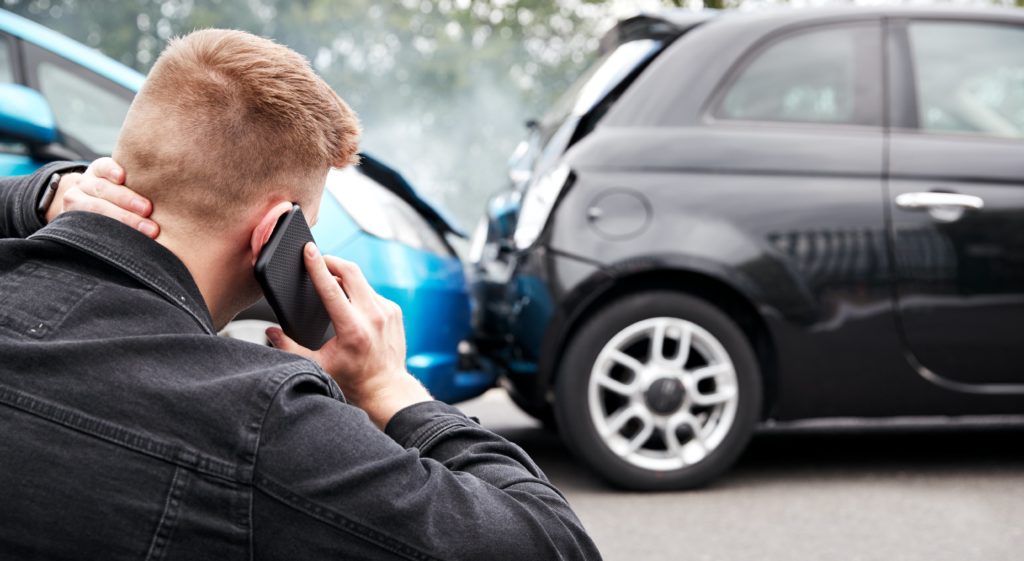With the uptick in car accidents, we wanted to share the steps you should take if you are in a car accident. We advise to take these 14 steps to protect yourself and prepare for the insurance claim process or a possible car accident lawsuit from the other party involved:
Step 1: Don’t Leave the Scene
Don’t leave the scene of the accident until you’ve exchanged information with others involved in the crash or if an office is investigating.
Step 2: Check for Injuries
Figure out if anyone was injured, starting with you and your passengers. Then, if it’s safe to do so, check on other drivers and passengers. If you discover any injuries, immediately call 911.
Step 3: Call the Police
If you’ve called 911, a police officer will arrive to the scene of the accident. You have to call the police if property damage exceeds a certain amount set by state law (typically around $1,000, but less in some states). The exact cost of damage is impossible to know at the scene and a police report will be needed to file an insurance claim, so it’s often best to get a police report.
The officer will speak to everyone involved in the accident to get statements for the report. It will be especially important and helpful to get law enforcement involved of the other party involved in the accident is driving under the influence or driving without auto insurance. Be sure to jot down the name and even the badge number of the responding officer, as well as the police report number if possible.
Step 4: Move Vehicles
If the accident is fairly minor with no serious injuries, try to get all vehicles moved over to the shoulder of the road and away from oncoming and ongoing traffic. This will also help to assist first responders in their quest to reach the scene of the accident.
Step 5: Exchange Insurance and Contact Information
Identify the other drivers involved in your accident and get their names, contact information, driver’s license numbers, and car insurance details (company, policy number). This will usually be in the form of a Driver Exchange form. If the driver of the car isn’t the owner of the car, be sure to get the vehicle’s owner’s information too. To prevent possible transcription errors when exchanging information, it is a good idea to take a picture of the other driver’s insurance card and driver’s license and email or text it to yourself. If there are witnesses to the accident, get their names and contact information. Your insurance company or attorney may need their testimony to confirm your account of what happened.
Step 6: Gather Potential Evidence
Take pictures of any vehicle damage, skid marks on the road, traffic signals, and area conditions that will be crucial prove your statement and help in the claim process and any liability battle. Also be sure to take note of the year, make, model, license plate number, and description of the vehicles involved in the accident. Another potential key piece of evidence could be any captured camera footage. Look around to see if there are any cameras nearby, such as surveillance or doorbell cameras. Make note of their location and try to work out who to contact to ask for recorded footage.
Step 7: Watch What You Say
We know emotions run high after an accident and the shock and stress of the incident can make you confused, distracted, and feel bad about the whole situation. Regardless of how you feel or what your opinion is about who or what may have caused the accident, watch what you say at the scene of the car accident. NEVER admit fault to the other driver or police officer, even if you truly believe you’re at fault, because statements like this can be used against you. The facts may come out later that show you were mistaken.
Step 8: Don’t Wait to Seek Medical Care
After your car accident, if you feel even the slightest hint of injury, or just have the sense that something’s not right with you physically, it’s important to get medical attention as soon as possible. Your health is our first concern, and it should be your first concern, too. Getting the necessary medical treatment after a car accident will result in having medical bills and records that will strengthen any car accident injury claim you make.
Step 9: Write Out What Happened
When you can finally find a quiet moment to settle down, write out exactly what happened, as best as you can remember. Be sure to try to include the following information to the best of your ability:
- the specific location, time, and date of the accident
- the direction you were driving
- your location on the road and what you were doing at the moment of impact
- what the other car was doing at the time of the accident
Step 10: Notify Your Car Insurance Company or Insurance Agent
Your car insurance company will have a number to call to report the accident, or if you have an insurance agent, call them to report the details of the accident and they will be able to file a claim on your behalf.
It’s important to notify your car insurance company or agent as soon as possible, regardless of who is or may be at fault. Your policy requires you to promptly notify your insurance company of any incident that could trigger coverage. Failure to provide timely notice to your car insurance company could jeopardize your coverage. You may talk to your agent about the advantages and disadvantages of filing a claim and how it may affect your auto insurance premium.
Step 11: Cooperate With Your Car Insurance Company
You typically have a duty to cooperate with your car insurance company’s investigation into the accident. That means you should answer their questions and provide them with evidence or information you collected following the accident. Though if you feel like your car insurance company is wrongfully denying your claim, or you may have criminal liability for the accident, consider contacting an attorney.
Step 12: Keep Careful Records
If you have to get medical treatment or vehicle repairs, keep records of everything. Even if you don’t plan on filing a claim, you might change your mind and you’ll need records to show your accident-related losses.
Keep a journal to note your injuries and how they impact your daily life. You should also keep a record of correspondence between who you talk to and what you talk about regarding the incident. Do not to delete any emails you exchange with anyone about the accident.
If you are one of our clients and have been involved in a car accident, please give us a call ASAP so we can guide you in the next steps.
Source: “What to Do after a Car Accident.” www.nolo.com,
www.nolo.com/legal-encyclopedia/what-to-do-after-a-car-accident.html.


